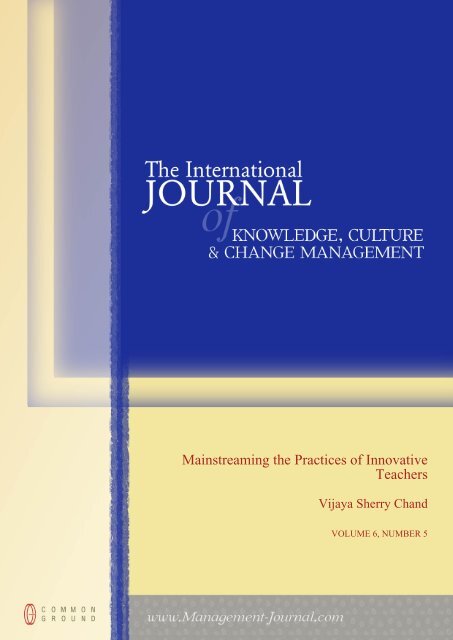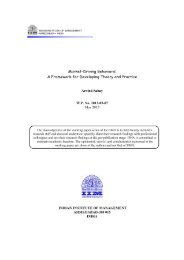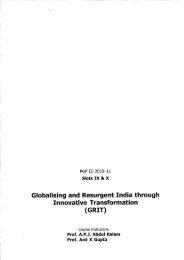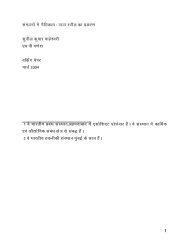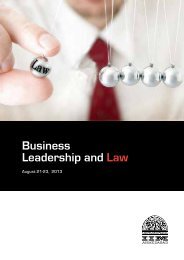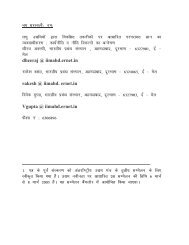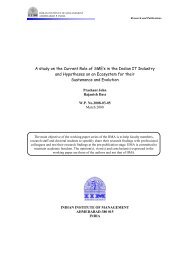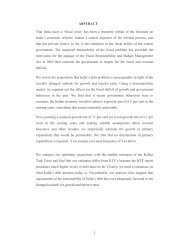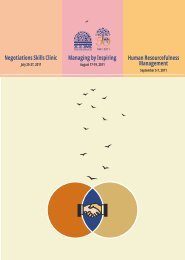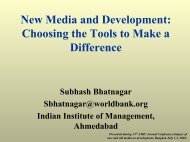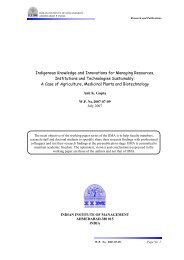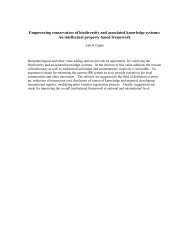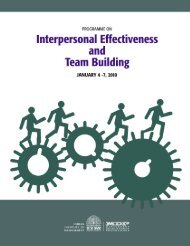related paper - Indian Institute of Management, Ahmedabad
related paper - Indian Institute of Management, Ahmedabad
related paper - Indian Institute of Management, Ahmedabad
You also want an ePaper? Increase the reach of your titles
YUMPU automatically turns print PDFs into web optimized ePapers that Google loves.
Mainstreaming the Practices <strong>of</strong> Innovative<br />
Teachers<br />
Vijaya Sherry Chand<br />
VOLUME 6, NUMBER 5
INTERNATIONAL JOURNAL OF KNOWLEDGE, CULTURE AND CHANGE MANAGEMENT<br />
http://www.<strong>Management</strong>-Journal.com<br />
First published in 2006 in Melbourne, Australia by Common Ground Publishing Pty Ltd<br />
www.CommonGroundPublishing.com.<br />
© 2006 (this <strong>paper</strong>), the author(s)<br />
© 2006 (selection and editorial matter) Common Ground<br />
Authors are responsible for the accuracy <strong>of</strong> citations, quotations, diagrams, tables and maps.<br />
All rights reserved. Apart from fair use for the purposes <strong>of</strong> study, research, criticism or review as permitted under<br />
the Copyright Act (Australia), no part <strong>of</strong> this work may be reproduced without written permission from the<br />
publisher. For permissions and other inquiries, please contact .<br />
ISSN: 1447-9524<br />
Publisher Site: http://www.<strong>Management</strong>-Journal.com<br />
The INTERNATIONAL JOURNAL OF KNOWLEDGE, CULTURE AND CHANGE MANAGEMENT is a peer<br />
refereed journal. Full <strong>paper</strong>s submitted for publication are refereed by Associate Editors through anonymous<br />
referee processes.<br />
Typeset in Common Ground Markup Language using CGCreator multichannel typesetting system<br />
http://www.CommonGroundS<strong>of</strong>tware.com.
Mainstreaming the Practices <strong>of</strong> Innovative Teachers<br />
Managing Decentralized Pr<strong>of</strong>essional Development in Public Schooling<br />
Vijaya Sherry Chand, <strong>Indian</strong> <strong>Institute</strong> <strong>of</strong> <strong>Management</strong>, India<br />
Abstract: The formal state-run (public) schooling system in developing countries depends on a centrally-driven approach<br />
to the pr<strong>of</strong>essional development <strong>of</strong> its teacher workforce. The culture which underpins this approach is defined by hierarchy,<br />
centralized control <strong>of</strong> training delivery, an ethos which facilitates a downward ‘cascading’ transmission <strong>of</strong> expertise by<br />
knowledgeable authorities, and an assumed uniformity <strong>of</strong> training needs. This culture hinders the abstraction and processing<br />
<strong>of</strong> relevant and effective practices from the grassroots, resulting in the system’s inability to learn from the strengths within.<br />
An alternative culture that values peer-learning, sharing <strong>of</strong> experiences, validation <strong>of</strong> outstanding practices and development<br />
<strong>of</strong> learning material for use by decentralized pr<strong>of</strong>essional forums will promote key principles like self-learning, applying<br />
external practices to one’s own problems and monitoring self-development. This <strong>paper</strong> has outlined an “educational innovation<br />
bank” (EI Bank) initiative, drawing on processual theories <strong>of</strong> innovation that identify specific types <strong>of</strong> networks for<br />
the three “episodes” <strong>of</strong> innovation: design and development, diffusion and implementation, and the <strong>related</strong> knowledge<br />
transformation that is called for. The establishment <strong>of</strong> the EI Bank combines the social construction <strong>of</strong> knowledge by decentralized<br />
networks with knowledge objectification in the diffusion episode, through a process <strong>of</strong> screening and validating innovations<br />
and converting them into user-friendly products like case studies, a curriculum module and an open-access,<br />
searchable database <strong>of</strong> teachers’ practices. The use <strong>of</strong> the EI Bank calls for a return to local user-networks to adapt the<br />
objectified ideas in new contexts. Such an alternative approach demands that educational administrators perform three<br />
tasks—develop a learner-focused perspective, convert validated local knowledge into ‘products’ through appropriate networks,<br />
and undertake “policy entrepreneurship”—if they are to develop a culture <strong>of</strong> decentralized pr<strong>of</strong>essional development.<br />
Keywords: Culture <strong>of</strong> Decentralization, Pr<strong>of</strong>essional Development, Educational Innovations<br />
THE FORMAL STATE-RUN (public)<br />
schooling system in developing countries<br />
depends on a centrally-driven approach to<br />
the pr<strong>of</strong>essional development <strong>of</strong> its teacher<br />
workforce. The culture which underpins this approach<br />
is defined by hierarchy, centralized control<br />
<strong>of</strong> training delivery, an ethos which facilitates a<br />
downward ‘cascading’ transmission <strong>of</strong> expertise by<br />
knowledgeable authorities, and an assumed uniformity<br />
<strong>of</strong> training needs. This culture hinders the abstraction<br />
and processing <strong>of</strong> relevant and effective practices<br />
from the grassroots, resulting in the system’s inability<br />
to learn from the strengths within. An alternative<br />
culture that values peer-learning, sharing <strong>of</strong> experiences,<br />
validation <strong>of</strong> outstanding practices and development<br />
<strong>of</strong> learning material for use by decentralized<br />
pr<strong>of</strong>essional forums will promote key principles like<br />
self-learning, applying external practices to one’s<br />
own problems and monitoring self-development.<br />
This <strong>paper</strong> has outlined an “educational innovation<br />
bank” (EI Bank) initiative, drawing on processual<br />
theories <strong>of</strong> innovation that identify specific types <strong>of</strong><br />
networks for the three “episodes” <strong>of</strong> innovation:<br />
design and development, diffusion and implementation,<br />
and the <strong>related</strong> knowledge transformation that<br />
is called for. The establishment <strong>of</strong> the EI Bank<br />
combines the social construction <strong>of</strong> knowledge by<br />
decentralized networks with knowledge objectification<br />
in the diffusion episode, through a process <strong>of</strong><br />
screening and validating innovations and converting<br />
them into user-friendly products like case studies, a<br />
curriculum module and an open-access, searchable<br />
database <strong>of</strong> teachers’ practices. The use <strong>of</strong> the EI<br />
Bank calls for a return to local user-networks to adapt<br />
the objectified ideas in new contexts. Such an alternative<br />
approach demands that educational administrators<br />
perform three tasks—develop a learner-focused<br />
perspective, convert validated local knowledge into<br />
‘products’ through appropriate networks, and undertake<br />
“policy entrepreneurship”—if they are to develop<br />
a culture <strong>of</strong> decentralized pr<strong>of</strong>essional development.<br />
The context for this <strong>paper</strong> is the pr<strong>of</strong>essional development<br />
<strong>of</strong> teachers working in large formal staterun<br />
(public) schooling systems in developing countries<br />
like India. The approach to in-service teacher<br />
development in such systems has usually relied on<br />
top-down hierarchical delivery <strong>of</strong> training inputs in<br />
a ‘cascade’ mode. Some key assumptions made by<br />
such an approach are an assumed uniformity <strong>of</strong><br />
training needs and a ‘deficit’ reduction model <strong>of</strong> development<br />
which does not recognize the knowledge<br />
and practices <strong>of</strong> the teachers themselves. The cascade<br />
model—in spite <strong>of</strong> its limitations (Shaeffer 1993),<br />
INTERNATIONAL JOURNAL OF KNOWLEDGE, CULTURE AND CHANGE MANAGEMENT, VOLUME 6, NUMBER 5, 2006<br />
http://www.<strong>Management</strong>-Journal.com, ISSN 1447-9524<br />
© Common Ground, Vijaya Sherry Chand, All Rights Reserved, Permissions: cg-support@commongroundpublishing.com
18<br />
INTERNATIONAL JOURNAL OF KNOWLEDGE, CULTURE AND CHANGE MANAGEMENT, VOLUME 6<br />
and its well known drawbacks like ‘transmission<br />
loss’ and distortion <strong>of</strong> the message as it filters down<br />
to successively lower levels in the hierarchy <strong>of</strong><br />
training—is popular on account <strong>of</strong> the reach it<br />
provides (Chand and Amin-Choudhury 2004: 49-<br />
50). However, the culture that underpins this model<br />
does not encourage the abstraction <strong>of</strong> relevant and<br />
effective practices from the grassroots, ultimately<br />
resulting in the system’s inability to develop a<br />
learning culture within itself. Alternatives that value<br />
peer-learning, sharing <strong>of</strong> experiences, validation <strong>of</strong><br />
outstanding practices and development <strong>of</strong> learning<br />
material for use by teachers themselves, may be<br />
placed at the other end <strong>of</strong> the spectrum <strong>of</strong> teacher<br />
development approaches. But if public systems are<br />
to develop a learning culture that builds on these<br />
elements, they need to develop competence in combining<br />
top-down approaches with participatory<br />
learning methodologies (ibid.: 25-28) and learn to<br />
promote a “network space for teacher development”<br />
(Chand and Amin-Choudhury 2005: 286-288). This<br />
<strong>paper</strong> is concerned with the latter imperative. We<br />
first describe the concept <strong>of</strong> an “educational innovation<br />
bank” (EI Bank)—a clearing house for the work<br />
<strong>of</strong> outstanding primary school teachers in the public<br />
schooling system—and its implementation over a<br />
two and a half year period (2003-06). 1 We then apply<br />
theories that link innovation, knowledge and networking,<br />
to draw implications for the use <strong>of</strong> the model by<br />
administrators in the public system.<br />
A Clearinghouse for Educational<br />
Innovations<br />
The clearinghouse concept is built on an alternative<br />
teacher development philosophy that seeks to draw<br />
on the best practices among teachers working in<br />
state-run and funded primary schools. It was conceptualized<br />
as a network <strong>of</strong> (a) outstanding teachers who<br />
have implemented innovations with their own resources<br />
in order to overcome specific problems<br />
primarily concerned with classroom instructional<br />
quality, out-<strong>of</strong>-school learning among children, retaining<br />
children in school, enabling access to<br />
schooling for all children; (b) users most likely to<br />
benefit from these innovations (teachers working in<br />
state rural schools, teacher training institutions and<br />
educational administrators); (c) other interested<br />
stakeholders like policy makers.<br />
The development <strong>of</strong> the EI Bank involves scouting<br />
out, and validation, <strong>of</strong> educational innovations<br />
evolved by outstanding teachers, and making them<br />
available in usable forms to other stakeholders. The<br />
EI Bank thus aims at <strong>of</strong>fering an alternative solutionaugmenting<br />
teacher development approach, which<br />
can be spread and implemented by policy implementers<br />
and teacher training institutions in their own<br />
contexts. For the purposes <strong>of</strong> developing this EI<br />
Bank, an innovation was defined as an educational<br />
practice (method, learning tool or aid, or set <strong>of</strong> actions)<br />
which has actually been tried in practice and<br />
has achieved certain educational goals that the<br />
teacher set in his or her specific socio-economic<br />
context. That is, an innovation should have had the<br />
following characteristics: a novel and/or unique response<br />
to a problem or need; a stage <strong>of</strong> initial development<br />
by the teacher, followed by a stage <strong>of</strong> trial<br />
and monitoring (implementation); an evaluation,<br />
followed by continuation or modification; and finally,<br />
a set <strong>of</strong> results. ‘Effectiveness’ is understood to mean<br />
that the innovation has resulted in identifiable positive<br />
improvement in line with the educational objectives<br />
<strong>of</strong> the teacher. The specific criteria that have<br />
been used to characterize innovations for purposes<br />
<strong>of</strong> screening or rating have been: the novelty and<br />
uniqueness dimensions, the context in which the<br />
activity was undertaken (community/school background),<br />
the scope <strong>of</strong> any single activity in terms <strong>of</strong><br />
number <strong>of</strong> educational aspects affected/ number <strong>of</strong><br />
children who benefited, and the spread-effect <strong>of</strong> the<br />
innovation. This understanding <strong>of</strong> educational innovation<br />
conforms to the general understanding <strong>of</strong> innovation<br />
in literature (for instance, Rogers 1995;<br />
Carayannis et al. 2003).<br />
Preliminary Search for Innovations<br />
This crucial first step involved the following: the<br />
drafting <strong>of</strong> an announcement and its dissemination<br />
through <strong>of</strong>ficial channels; contacting teacher associations,<br />
non-governmental organizations and departmental<br />
functionaries for nominations; and the polling<br />
<strong>of</strong> colleges <strong>of</strong> education and teacher training institutions.<br />
The announcement described the purpose <strong>of</strong><br />
the exercise, the conditions that teachers should have<br />
fulfilled (innovated on their own, developed their<br />
own ideas, problem solving, and achievement <strong>of</strong><br />
educational goals), the guidelines/ format for writing<br />
up one’s work, and the procedures for screening.<br />
‘Partners’—interested individuals, teacher trainers<br />
or bureaucrats—were also involved at this stage so<br />
that the initial rudimentary networks that emerged<br />
had some non-teacher participation as well.<br />
Screening <strong>of</strong> Innovations<br />
This time-consuming step involved the study <strong>of</strong> the<br />
teachers’ written accounts for academic value and<br />
1 The EI Bank initiative, over the period 2003-06, has dealt with about 2400 innovative teachers. The work <strong>of</strong> 120 <strong>of</strong> these teachers has<br />
been converted into case studies, available in printed form as well on CDs. Summaries <strong>of</strong> the work <strong>of</strong> these teachers, and other short-listed<br />
teachers, are being organized in the form <strong>of</strong> a searchable electronic database.
VIJAYA SHERRY CHAND<br />
19<br />
teacher training potential. This was undertaken with<br />
the help <strong>of</strong> teacher experts/ outstanding teachers. The<br />
process <strong>of</strong> validation which followed used two approaches:<br />
teacher workshops during which peerquestioning<br />
helped a teacher refine and finalize her<br />
work, and visits by partners or outstanding teachers<br />
to the teacher sites for verification and further discussions.<br />
The validation process ended with seeking the<br />
written ‘prior informed consent’ <strong>of</strong> the innovative<br />
teacher for further dissemination <strong>of</strong> the innovation,<br />
and the agreement <strong>of</strong> the teacher to participate in the<br />
EI Bank. This ensured that the innovation was identified<br />
as the intellectual property <strong>of</strong> the teacher and<br />
that the ethical credibility <strong>of</strong> the project was assured,<br />
from the point <strong>of</strong> view <strong>of</strong> use <strong>of</strong> the project’s outputs<br />
by external stakeholders.<br />
Processing <strong>of</strong> Identified Innovations<br />
This step involved the conversion <strong>of</strong> the results <strong>of</strong><br />
the screening into teacher and trainer usable<br />
“products”—outputs like printed case studies or webdocuments<br />
that can be searched for solutions to particular<br />
problems. The initial focus has been on the<br />
printed form since the infrastructure needed for the<br />
multi-media format has still to be developed in many<br />
parts <strong>of</strong> the country. A searchable database is under<br />
development and has been used on a trial basis by<br />
teacher administrators. The key lesson indicated by<br />
the feedback (as <strong>of</strong> April 2006) is that administrators<br />
have realized that there are powerful and alternative<br />
modes <strong>of</strong> learning from teachers. (The sample database<br />
is available at www.sristi.org/rjmc. Two examples<br />
are summarised in an appendix to this <strong>paper</strong><br />
to give readers an idea <strong>of</strong> the nature <strong>of</strong> the innovations.)<br />
Dissemination <strong>of</strong> the Products to<br />
Stakeholders and Monitoring the<br />
Development <strong>of</strong> the ‘Network’<br />
This involves the sharing <strong>of</strong> the products and the<br />
monitoring <strong>of</strong> their use. Apart from the series <strong>of</strong> case<br />
studies—some <strong>of</strong> which have been serialized in<br />
teacher newsletters—the work <strong>of</strong> 120 teachers has<br />
been compiled into two yearbooks. The first was<br />
brought out in 2005; the second volume will be released<br />
in mid-2006. A parallel initiative has been the<br />
development <strong>of</strong> a “curriculum module” for educational<br />
administrators on how local knowledge can be<br />
networked and spread through the approach outlined<br />
above. This module was used for the first time in<br />
March 2006; the feedback highlights the importance<br />
<strong>of</strong> using easily understandable terms like “bank” to<br />
anchor the concept <strong>of</strong> networking local knowledge<br />
and to develop ‘user-friendly products’ which are<br />
easy to apply in one’s own context.<br />
Honouring Teachers: The Idea <strong>of</strong> a<br />
Fellowship<br />
One way <strong>of</strong> honouring the most outstanding teachers<br />
(about 60 every year) is through a conference where<br />
they get a chance to present their work and learn<br />
from other teachers. The first two such meets were<br />
held in December 2004 and December 2005. A<br />
second mechanism has been a modest fellowship or<br />
grant to help teachers complete incomplete innovative<br />
work.<br />
We now turn to a discussion <strong>of</strong> the experience <strong>of</strong><br />
this project’s implementation from the perspective<br />
<strong>of</strong> developing a network space for teacher development<br />
at the cutting edge <strong>of</strong> educational delivery, and<br />
linking it with the role that educational administrators<br />
and policy makers higher up in the hierarchy, can<br />
play in moving towards a more ‘bottom-up’ culture<br />
<strong>of</strong> pr<strong>of</strong>essional development in a public system.<br />
Discussion<br />
A model <strong>of</strong> teacher-driven capacity building mechanisms<br />
was outlined in Chand, Shukla and Solanki<br />
(1998: 24-25). This model is supportive <strong>of</strong> the conceptualization<br />
<strong>of</strong> the EI Bank described above, moves<br />
away from a focus on the psychological attributes<br />
<strong>of</strong> good and successful teachers, and builds on the<br />
“local knowledge” such teachers have generated.<br />
This <strong>paper</strong> does not deal with the initial stages<br />
through which the teacher-contributors to the EI<br />
Bank have passed while developing their innovations.<br />
During this period, the role <strong>of</strong> tacit knowledge (Polanyi<br />
1983) is crucial, especially when teachers have<br />
had to struggle with their socio-economically and<br />
educationally disadvantaged contexts. Tacit knowledge<br />
comes to the fore when a firm’s personnel—in<br />
this case, teachers—face some problem (Nonaka and<br />
Takeuchi 1995). Using this to develop ‘solution<br />
knowledge’ (Saemundsson 2004), is a crucial initial<br />
achievement. Saemundsson, in the context <strong>of</strong> ‘technical<br />
knowledge’, identifies three domains in which<br />
such knowledge operates: knowledge <strong>of</strong> human goals<br />
and aspirations (since artefacts are logically <strong>related</strong><br />
to these), the interaction between the natural world<br />
and the artefacts, and methods to “use the artificial<br />
world”. Knowledge in all three domains can be explicit<br />
or tacit. He identifies knowledge in the first<br />
domain as “problem knowledge” and knowledge in<br />
the other two as “solution knowledge”. The knowledge<br />
that teachers develop in response to their concrete<br />
contexts may be equated with technical knowledge;<br />
(see Chand, Amin-Choudhury, and Joshi 2005<br />
for a range <strong>of</strong> solutions, including teaching-learning<br />
material artefacts and the technical interventions,<br />
developed by the teachers). More specifically, the<br />
‘solution knowledge’ thus developed has resulted in<br />
the teachers’ adopting a variety <strong>of</strong> new roles—roles
20<br />
INTERNATIONAL JOURNAL OF KNOWLEDGE, CULTURE AND CHANGE MANAGEMENT, VOLUME 6<br />
for which their pre-service training does not usually<br />
prepare them.<br />
These roles, which focus on extra-school and<br />
community-<strong>related</strong> activities, constitute a “socioeducational<br />
entrepreneurial” identity which the<br />
teachers create for themselves. Chand and Amin-<br />
Choudhury (2006, forthcoming) examine how this<br />
process <strong>of</strong> redefining a formal pr<strong>of</strong>essional role to<br />
include extra-school roles and behaviours takes<br />
place. 2 Such identity formation is accompanied by<br />
the development <strong>of</strong> local, teacher-initiated, community<br />
networks. These in turn communicate community<br />
expectations to the teachers, who usually respond<br />
by working out a broader vision <strong>of</strong> educational<br />
development. The teachers then command the respect<br />
<strong>of</strong> the local community and develop a certain ‘moral<br />
authority’ which helps them improve educational<br />
performance.<br />
What has been noted above summarizes the personal<br />
development process that the teachers who are<br />
contributors to the EI Bank have gone through. The<br />
contributors to the EI Bank should be termed “expert”<br />
teachers, who may or may not be “experienced”<br />
(Day 1999). Day’s distinction between expertise and<br />
experience is relevant because some users <strong>of</strong> the EI<br />
Bank may have reached an advanced stage in their<br />
careers and may benefit from reflecting on the fit<br />
between what they have experienced themselves and<br />
practices learned from elsewhere. Thus, the innovations<br />
<strong>of</strong> the selected teachers should highlight the<br />
interplay between the teachers’ life histories, their<br />
own development, their classroom settings and the<br />
broader social and political contexts in which they<br />
work—leading to an understanding <strong>of</strong> how such<br />
teachers have constructed their personal and pr<strong>of</strong>essional<br />
identities in order to develop educational<br />
knowledge. The teacher users <strong>of</strong> the products <strong>of</strong> the<br />
EI Bank have highlighted this dimension as helpful<br />
in promoting their own reflective practice.<br />
The process <strong>of</strong> bringing together teachers who<br />
have used their ‘solution knowledge’ for problem<br />
solving is itself critical, from the point <strong>of</strong> view <strong>of</strong><br />
integrating the three forms <strong>of</strong> teacher learning—natural/evolutionary,<br />
opportunistic, and planned or accelerated—recommended<br />
by Day (1999). This integration<br />
is possible only when a “learner-focused perspective”<br />
(in contrast to a training-focused perspective)<br />
is adopted. In other words, teachers learn from<br />
their own educational experiences (when their life<br />
histories evolve) and by solving problems through<br />
a trial-and-error process (opportunistic learning).<br />
These experiences are <strong>of</strong> value when a community<br />
<strong>of</strong> teachers is forced to accelerate its learning. The<br />
valorisation <strong>of</strong> teachers’ knowledge and reflective<br />
learning implied by this perspective also supports<br />
recent emphasis on self-driven, lifelong learning<br />
approaches to teacher development. The first task<br />
for educational administrators is, therefore, developing<br />
an appreciation <strong>of</strong> this perspective <strong>of</strong> ‘learning<br />
from the grassroots’, so that they are able to promote<br />
a more bottom-up culture in their training bureaucracies.<br />
An associated impact <strong>of</strong> ‘organizing’ teachers who<br />
have used their ‘solution knowledge’ has been the<br />
extension <strong>of</strong> local teacher-driven networks into a<br />
broader network that includes fellow pr<strong>of</strong>essionals.<br />
Chand and Amin-Choudhury (2005) discuss how<br />
individual innovation has been usually confined to<br />
the “closed individual cycle” <strong>of</strong> teacher development,<br />
with the knowledge that the teachers have gained<br />
remaining “embodied” (Huberman 2001: 144) in the<br />
individual. Extending this to the “open collective<br />
cycle” identified by Huberman (2001: 149-156) as<br />
an alternative teacher development network, is especially<br />
important in a societal culture that does not<br />
provide teachers with enough opportunity to share<br />
their successes, failures and approaches, or their<br />
struggles at work in geographical isolation, as the<br />
case has been with almost all the contributors to the<br />
EI Bank. Many <strong>of</strong> them had already moved into the<br />
“open individual cycle” (in which the teacher reaches<br />
outside the classroom) by the time they were identified.<br />
But it is essential to build on this rudimentary<br />
networking experience to shift into the closed collective<br />
cycle (in which the search for solutions is “closer<br />
to a collective enterprise, but one without resources<br />
from outside the group”), and then to the open collective<br />
cycle that relies on networking with more<br />
fluid borders (with the participation <strong>of</strong> outsider experts),<br />
for the diffusion <strong>of</strong> local innovations. Participation<br />
<strong>of</strong> other network stakeholders—non-governmental<br />
actors perhaps—in this open cycle helps legitimise<br />
teacher experiences in a network space<br />
(Goodson 2000). The main facilitators <strong>of</strong> the shift<br />
(Huberman 2001) are: conceptual inputs, experience<br />
sharing, didactic leads provided by outsiders, pedagogical<br />
analysis, and exchanges. The EI Bank shortens<br />
the cycle by condensing the stage <strong>of</strong> generating inputs<br />
and experience sharing, and facilitating exchanges<br />
and analysis through workshops and through<br />
the participation <strong>of</strong> outside experts.<br />
The extension <strong>of</strong> the knowledge and innovations<br />
<strong>of</strong> teachers into the “open collective cycle”, as illustrated<br />
by the processing and dissemination stages <strong>of</strong><br />
the EI Bank approach described earlier, is the second<br />
key task for administrators. Innovation as a reason<br />
for developing network forms, and the role <strong>of</strong> networks<br />
in promoting innovations, are well known.<br />
2 Analogous to these behaviours is organizational citizenship performance by individuals (Organ et al. 2006; Van Dyne et al. 1995), through<br />
which individuals exhibit behaviours that are not likely to be formally rewarded or forced upon them, but which ultimately benefit a collective—in<br />
this case, the rural communities which the teachers serve.
VIJAYA SHERRY CHAND<br />
21<br />
Here we specifically use the theoretical model linking<br />
innovation, knowledge and networks, developed by<br />
Swan et al. (2003), to examine how the EI Bank can<br />
be adopted and implemented by educational administrators<br />
working at a regional or national level. Swan<br />
et al. conceptualize innovation as a set <strong>of</strong> “episodic”<br />
processes, which cover the three stages <strong>of</strong> design<br />
and development or the “invention episode”, the<br />
spread or the “diffusion episode” and the adoption<br />
<strong>of</strong> new ideas by others, the “implementation episode”.<br />
These three episodes are not structured linearly<br />
or sequentially; rather, they are to be seen as iterative<br />
and recursive processes. The key insight that Swan<br />
et al. provide is that specific types <strong>of</strong> networks and<br />
network activities are required during particular<br />
episodes. Innovation, thus, is “reciprocally and systematically<br />
intertwined” with the creation and<br />
maintenance <strong>of</strong> networks. Such a processual view<br />
<strong>of</strong> networks sees innovation as flows and combinations<br />
<strong>of</strong> knowledge and information, which are open<br />
to reshaping. Networking involves “the active search<br />
and development <strong>of</strong> ideas, knowledge and information<br />
through the creation and articulation <strong>of</strong> informal<br />
relationships within a context <strong>of</strong> more formal intraand<br />
inter-organizational structural arrangements”<br />
(ibid.: 681). Thus, networking processes can span<br />
different structures (hierarchies as well as more<br />
loosely-structured units). In summary, roles <strong>of</strong> networks<br />
vary across episodes; knowledge transformation<br />
(construction, communication and exchange) is<br />
one <strong>of</strong> the roles <strong>of</strong> such networks; the processual dimensions<br />
<strong>of</strong> networks should not be ignored; personal<br />
sense-making and trust-building change as networks<br />
evolve; and different kinds <strong>of</strong> knowledge have<br />
different implications for the specific roles <strong>of</strong> networks.<br />
From more local and intra-organizational networking<br />
during the invention episode, the focus shifts to<br />
wider networks for knowledge objectification in the<br />
diffusion episode and then returns to more local<br />
networks in new contexts so that knowledge appropriation<br />
or implementation becomes possible in these<br />
new contexts. During the invention episode, social<br />
construction <strong>of</strong> knowledge, free and extensive exchange<br />
<strong>of</strong> ideas interpersonally, and loose interpersonal<br />
structures which crystallize ideas, are important.<br />
Rogers (1995) also stresses the importance <strong>of</strong><br />
the “communicated experience” <strong>of</strong> the immediate<br />
peer circle; the implication is that teachers who are<br />
networked in an invention episode will have more<br />
faith in their partners who have generated the idea.<br />
In the EI Bank initiative, the early stages <strong>of</strong> teacher<br />
identification and networking, subjecting innovations<br />
to peer scrutiny and the screening procedures used,<br />
served the purpose <strong>of</strong> the social construction <strong>of</strong><br />
‘solution knowledge’. The conferences and fellowships<br />
that were built into the project also helped in<br />
the creation <strong>of</strong> loose interpersonal structures—evidence<br />
is provided by some <strong>of</strong> the teachers using the<br />
fellowships they received to try out things their peers<br />
in the face-to-face network had evolved.<br />
In the diffusion episode, commoditization—making<br />
tacit knowledge explicit—is more important.<br />
Diffusion ceases to be dependent on the tacit knowledge<br />
<strong>of</strong> its creators. The network’s role is thus legitimation<br />
and communication <strong>of</strong> objectified and<br />
“commodified” knowledge using best practice<br />
methodologies. Networks that communicate also<br />
validate or legitimate. Boundary spanning individuals<br />
or “honest brokers” play an important role at this<br />
stage, and there is a reliance on surrogate indices <strong>of</strong><br />
the validity <strong>of</strong> the knowledge being diffused. This<br />
is the rationale for processing the practices into<br />
printed cases, yearbooks <strong>of</strong> innovations, and a<br />
searchable database, so that other stakeholders can<br />
access such knowledge through “user-friendly”<br />
formats. The prior informed consents <strong>of</strong> the teachers<br />
and the role <strong>of</strong> outside experts in validation also<br />
served to legitimize the knowledge that was converted<br />
into products. Such “network communications”<br />
screen the identified innovations on the basis <strong>of</strong><br />
merit and “actors <strong>of</strong> poor character and judgment,<br />
as well as poorly conceived ideas, are quickly identified<br />
and discredited” (Mintrom and Vergari 1998:<br />
128).<br />
The implementation episode deals with the appropriation<br />
<strong>of</strong> objectified ideas and adaptation <strong>of</strong> these<br />
to new local contexts in which the implementation<br />
happens—in other words, the objectified ideas need<br />
to be blended with the tacit knowledge that exists in<br />
the new contexts. The networking processes at this<br />
stage are purposeful and intentional, and the focus<br />
is on exchange <strong>of</strong> information and resources. The<br />
nature <strong>of</strong> knowledge transformation at this stage is<br />
best characterized as unpacking knowledge and recombining<br />
it with the local knowledge that exists in<br />
new contexts.<br />
This third episode needs to be visualized carefully<br />
since local knowledge evolved in contexts <strong>of</strong> socioeducational<br />
deprivation by the creator-teachers has<br />
to be “unpacked” and re-contextualized in new contexts,<br />
and blended with the tacit knowledge that userteachers<br />
in the new contexts possess. The network<br />
relevant to this episode includes a wider cross-section<br />
<strong>of</strong> stakeholders, including administrators who are<br />
hopefully sensitized to the value <strong>of</strong> an approach that<br />
‘builds on the strengths within’. Though the EI Bank<br />
has tried out a curriculum module and demonstration<br />
<strong>of</strong> model to educational administrators, as mechanisms<br />
to communicate this third episode, it may be<br />
more useful, during this episode, to stress the concept<br />
<strong>of</strong> “policy entrepreneurs”.<br />
Educational administrators usually visualize innovation<br />
in terms <strong>of</strong> the two broad strategies <strong>of</strong> educa-
22<br />
INTERNATIONAL JOURNAL OF KNOWLEDGE, CULTURE AND CHANGE MANAGEMENT, VOLUME 6<br />
tional innovation identified by Westera (2004: 508-<br />
510): substitution and transformation. The substitution<br />
strategy is an incremental approach whereas the<br />
transformational strategy proposes a “dramatic<br />
jump”. Each would ascribe different roles to the way<br />
in which technology-induced innovation has to be<br />
understood. Westera overcomes this simplistic dichotomy<br />
by applying Borgmann’s devices paradigm<br />
(making apparent the relationship between a commodity<br />
and its machinery, for instance, in any device<br />
or educational aid) and the concept <strong>of</strong> “focal practices”—activities<br />
that call for intrinsic involvement<br />
and strengthen the existential relationship <strong>of</strong> humans<br />
with the world (Borgmann 1984). He lists four principles<br />
that technology-based educational innovation<br />
can use: ensuring transparent and interactive devices;<br />
stressing products as carriers <strong>of</strong> meaning; going<br />
beyond efficiency; and paying attention to political<br />
meaning—“life demands a mixed mode <strong>of</strong> developing<br />
new ideas and preserving former achievements”<br />
(Westera 2004: 516). It is these principles, especially<br />
the last one, that provide the rationale for building<br />
on what the grassroots teacher-craftsmen know, by<br />
using alternative modes <strong>of</strong> communication in the<br />
diffusion and implementation episodic stages. An<br />
understanding <strong>of</strong> these principles would also help<br />
administrators integrate teacher workshops with<br />
multiple modes <strong>of</strong> diffusion—printed matter and<br />
website-based communication, for instance.<br />
Key administrators also need to be involved in all<br />
three episodes since, as Ramesh (2005) points out,<br />
while discussing innovation in bureaucratic systems,<br />
the genesis phase <strong>of</strong> innovation has not received as<br />
much attention as the implementation phase among<br />
bureaucrats working in public systems. He identifies<br />
‘framing’ an issue (what will be focused on) as important<br />
in understanding innovation in public systems,<br />
and suggests that the innovation should reach<br />
“a wider circle at the genesis or conceptual stage itself<br />
to gain acceptability” (ibid.: 47). Thus, the involvement<br />
<strong>of</strong> as many administrators as possible at<br />
the invention episode stage would help them frame<br />
the issue <strong>of</strong> valorising local innovations and knowledge<br />
in the context <strong>of</strong> wider diffusion and implementation.<br />
It would also help administrators move into<br />
the role <strong>of</strong> “policy entrepreneurs” (Mintrom and<br />
Vergari 1998), who as actors embedded in policy<br />
networks, will be able to direct the diffusion <strong>of</strong> innovations<br />
through their “direct and indirect contact<br />
with one another” (ibid.: 128). Playing this role is<br />
essential if bureaucrats committed to change are to<br />
develop a teacher network space and a culture supportive<br />
<strong>of</strong> decentralized pr<strong>of</strong>essional development<br />
within their own departments.<br />
This <strong>paper</strong> has focused on developing a culture<br />
that values a “learner-focused perspective” (in contrast<br />
to a training-focused perspective) and promotes<br />
a “network space for teacher development” in public<br />
educational systems responsible for pr<strong>of</strong>essional<br />
growth. The “Educational Innovation Bank” (EI<br />
Bank) described here builds on the concept <strong>of</strong> a<br />
clearinghouse and links the knowledge and innovations<br />
<strong>of</strong> outstanding teachers with networks that draw<br />
into them potential users <strong>of</strong> the Bank and other<br />
stakeholders. The implied valorisation <strong>of</strong> teachers’<br />
knowledge and innovations means that educational<br />
administrators have to learn to ‘learn from the<br />
grassroots’. The <strong>paper</strong> has drawn on processual theories<br />
<strong>of</strong> innovation which identify specific types <strong>of</strong><br />
networks for the three “episodes” <strong>of</strong> design and development,<br />
diffusion and implementation, to illustrate<br />
the kinds <strong>of</strong> knowledge transformation called for.<br />
The establishment <strong>of</strong> the EI Bank combines the social<br />
construction <strong>of</strong> knowledge among loose decentralized<br />
networks with knowledge objectification in the diffusion<br />
episode, through a process <strong>of</strong> screening and<br />
validating innovations, and converting them into<br />
user-friendly products. A second task for administrators<br />
is to link the innovations through broader networks<br />
that involve fellow pr<strong>of</strong>essionals and nonteacher<br />
experts, so that the design and diffusion<br />
episodes take root. The use <strong>of</strong> the EI Bank calls for<br />
a return to local networks, but networks <strong>of</strong> users, in<br />
order to appropriate the legitimised knowledge and<br />
objectified ideas in new contexts. Educational administrators<br />
have to play the role <strong>of</strong> policy entrepreneurs<br />
during these episodes <strong>of</strong> extended diffusion and implementation.<br />
These three tasks—developing an appreciation<br />
<strong>of</strong> a learner-focused perspective, converting<br />
validated local knowledge into ‘products’ through<br />
appropriate networks, and undertaking “policy entrepreneurship”—are<br />
crucial if administrators are to<br />
develop a culture <strong>of</strong> decentralized pr<strong>of</strong>essional development.<br />
Acknowledgements<br />
The project on which this <strong>paper</strong> draws upon was<br />
funded by a grant from the Sir Ratan Tata Trust,<br />
Mumbai, India. The author thanks Ms. Geeta Amin-<br />
Choudhury for coordinating the identification <strong>of</strong><br />
teachers and validation <strong>of</strong> their work.<br />
References<br />
Borgmann, A. 1984. Technology and the character <strong>of</strong> contemporary life. Chicago: University <strong>of</strong> Chicago Press.
VIJAYA SHERRY CHAND<br />
23<br />
Carayannis, E. G., E. Gonzalez, and J. J. Wetter. 2003. The nature and dynamics <strong>of</strong> discontinuous and disruptive innovations<br />
from a learning and knowledge management perspective. In The international handbook on innovation, ed. L. V.<br />
Shavinina. Oxford: Elsevier Science Ltd., pp 115-138.<br />
Chand, Vijaya Sherry, and G. Amin-Choudhury. 2004. Reformulating the early primary curriculum: Implementing a ‘progressivist’<br />
approach. Gandhinagar: Gujarat Council <strong>of</strong> Educational Research and Training, Government <strong>of</strong> Gujarat.<br />
———. 2005. Learning from ‘interpreted’ work contexts: Planned educational change and teacher development. In<br />
Teacher pr<strong>of</strong>essional development in changing conditions, eds. D. Beijaard, P.C. Meijer, G. Morine-Dershimer,<br />
and H. Tillema. Dordrecht: Springer, pp 275-289.<br />
———. 2006, forthcoming. Teachers and socio-educational entrepreneurship: Competence as a consequence. Journal <strong>of</strong><br />
Entrepreneurship.<br />
Chand, Vijaya Sherry, G. Amin-Choudhury, and S. Joshi, eds. 2005. Universalisation has to be from the village upwards:<br />
Primary school teachers’ innovations, First Yearbook. <strong>Ahmedabad</strong>: <strong>Indian</strong> <strong>Institute</strong> <strong>of</strong> <strong>Management</strong>, Ravi J.<br />
Matthai Centre for Educational Innovation.<br />
Chand, Vijaya Sherry, S. R. Shukla, and A.M. Solanki. 1998. Innovative teachers and innovations: Capability building for<br />
improving educational performance. Perspectives in Education 14 (1): 15-25.<br />
Day, C. 1999. Developing teachers: The challenges <strong>of</strong> lifelong learning. London: Falmer Press.<br />
Goodson, I. 2000. Pr<strong>of</strong>essional knowledge and the teacher’s life and work. In The life and work <strong>of</strong> teachers: International<br />
perspectives in changing times, eds. C. Day, A. Fernandez, T. E. Hauge, and J. Moller. London: Falmer Press.<br />
Huberman, M. 2001. Networks that alter teaching: Conceptualizations, exchanges and experiments. In Teacher development:<br />
Exploring our own practice, eds. J. Soler, A. Craft, and H. Burgess. London: Paul Chapman Publishing Ltd., in<br />
association with The Open University, pp 141-159. Originally published in Teachers & Teaching 1 (2): 193-211.<br />
Mintrom, M., and S. Vergari. 1998. Policy networks and innovation diffusion: The case <strong>of</strong> state education reforms. The<br />
Journal <strong>of</strong> Politics 60 (1): 126-148.<br />
Nonaka, I., and H. Takeuchi. 1995. The knowledge-creating company: How Japanese companies create the dynamics <strong>of</strong><br />
innovation. New York: Oxford University Press.<br />
Organ, D. W., P. M. Podsak<strong>of</strong>f, and S. B. Mackenzie. 2006. Organizational citizenship behavior: Its nature, antecedents<br />
and consequences. Thousand Oaks: Sage.<br />
Polanyi, M. 1983. The tacit dimension. Gloucester, MA: Peter Smith.<br />
Ramesh, G. 2005. Innovation in public systems — Genesis phase. IIMB <strong>Management</strong> Review, June 2005, pp 41-49.<br />
Rogers, E. M. 1995. Diffusion <strong>of</strong> innovations. 4th ed. New York: The Free Press.<br />
Saemundsson, R. J. 2004. Technical knowledge-seeking in a young and growing technology-based firm: Incentives and<br />
direction. International Journal <strong>of</strong> Innovation <strong>Management</strong> 8 (4): 399-429.<br />
Shaeffer, S. 1993. Participatory approaches to teacher training. In Teachers in developing countries: Improving effectiveness<br />
and managing costs, eds. J. P. Farrell, and J. B. Oliveira. Washington, D.C.: The World Bank.<br />
Swan, J., H. Scarbrough, and M. Robertson. 2003. Linking knowledge, networking and innovation processes: A conceptual<br />
model. In The international handbook on innovation, ed. L. V. Shavinina. Oxford: Elsevier Science Ltd., pp 680-<br />
694.<br />
Van Dyne, L., L. L. Cummings, and J. M. Parks. 1995. Extra-role behaviors: In pursuit <strong>of</strong> construct and definitional clarity<br />
(A bridge over muddied waters). Research in Organizational Behavior 17:215-285.<br />
Westera, W. 2004. On strategies <strong>of</strong> educational innovation: Between substitution and transformation. Higher Education<br />
47:501-517.<br />
Appendix<br />
Ramanlal Soni’s experiment in teaching numbers 1 to 100: While teaching grade one children in the 1970s,<br />
I found they made simple mistakes in writing double-digit numbers. Very <strong>of</strong>ten, the order <strong>of</strong> the numbers was<br />
reversed. For instance, when asked to write 26, the children wrote 62. This problem is peculiar to <strong>Indian</strong> languages<br />
like Hindi and Gujarati. After reflecting on such mistakes I identified the source <strong>of</strong> the problem in the attempt<br />
<strong>of</strong> the children to imitate the spoken form <strong>of</strong> the number. For instance the number 26, in Gujarati, was called<br />
out six-twenty, implying six and twenty. Since the six was spoken first, the children wrote the six first and then<br />
added the two, to represent the twenty. I changed my pedagogy <strong>of</strong> teaching numbers. First I taught the children<br />
the tens—10, 20, 30, and so on, up to a hundred. Then I started teaching the units series. I also developed a<br />
system <strong>of</strong> calling out numbers in Gujarati which followed the pattern <strong>of</strong> the English language. For instance, 26<br />
would be pronounced twenty and six. By this method I could teach young children to write and read numbers<br />
correctly, in words and figures, in just a 15-day period.<br />
Thakarshi Kunbar’s Birthday Greetings idea: Many <strong>of</strong> my students were from deprived families engaged<br />
in production <strong>of</strong> salt. It was difficult for the parents to enrol them in school. I first printed greeting cards. I then<br />
collected the dates <strong>of</strong> birth <strong>of</strong> all the children, and sent them greeting cards on their birthdays. Receiving such<br />
a card became an important occasion for the parents, since most <strong>of</strong> them did not keep track <strong>of</strong> the birthdays <strong>of</strong><br />
their children. The first 500 cards were gifted by the village. Later on, well-<strong>of</strong>f parents supplied the cards to the<br />
school. This practice continues and has served to maintain the good relations between parents and the school.<br />
More importantly, parents <strong>of</strong> children who are yet to reach school-going age are reminded regularly that “so
24<br />
INTERNATIONAL JOURNAL OF KNOWLEDGE, CULTURE AND CHANGE MANAGEMENT, VOLUME 6<br />
many years are left for enrolment”. This creates a moral pressure on the parents to acknowledge the teacher’s<br />
interest.<br />
About the Author<br />
Dr. Vijaya Sherry Chand<br />
Areas <strong>of</strong> interest include performance in basic education, management <strong>of</strong> decentralization in public educational<br />
systems and innovations <strong>of</strong> teachers.
THE INTERNATIONAL JOURNAL OF KNOWLEDGE, CULTURE AND<br />
CHANGE MANAGEMENT<br />
EDITORS<br />
Mary Kalantzis, University <strong>of</strong> Illinois, Urbana-Champaign, USA.<br />
Bill Cope, University <strong>of</strong> Illinois, Urbana-Champaign, USA.<br />
EDITORIAL ADVISORY BOARD<br />
Verna Allee, Verna Allee Associates, California, USA.<br />
Zainal Ariffin, Universiti Sains Malaysia, Penang, Malaysia.<br />
Robert Brooks, Monash University, Melbourne, Australia.<br />
Bruce Cronin, University <strong>of</strong> Greenwich, UK.<br />
Rod Dilnutt, William Bethway and Associates, Melbourne, Australia.<br />
Judith Ellis, Enterprise Knowledge, Melbourne, Australia.<br />
Andrea Fried, Chemnitz University <strong>of</strong> Technology, Germany.<br />
David Gurteen, Gurteen Knowledge, UK.<br />
David Hakken, University <strong>of</strong> <strong>Indian</strong>a, Bloomington, <strong>Indian</strong>a, USA.<br />
Sabine H<strong>of</strong>fmann, Macquarie University, Australia.<br />
Stavros Ioannides, Pantion University, Athens, Greece.<br />
Margaret Jackson, RMIT University, Melbourne, Australia.<br />
Paul James, RMIT University, Melbourne, Australia.<br />
Leslie Johnson, University <strong>of</strong> Greenwich, UK.<br />
Eleni Karantzola, University <strong>of</strong> the Aegean, Rhodes, Greece.<br />
Gerasimos Kouzelis, University <strong>of</strong> Athens, Greece.<br />
Krishan Kumar, University <strong>of</strong> Virginia, USA.<br />
Martyn Laycock, University <strong>of</strong> Greenwich and managingtransitions.net, UK.<br />
David Lyon, Queens University, Ontario, Canada.<br />
Bill Martin, RMIT University, Melbourne, Australia.<br />
Pumela Msweli-Mbanga, University <strong>of</strong> Kwazulu-Natal, South Africa.<br />
Gita Sankaran, Southern Cross University, Australia.<br />
Claudia Schmitz, Cenandu Learning Agency, Germany.<br />
Kirpal Singh, Singapore <strong>Management</strong> University, Singapore.<br />
Dave Snowden, Cynefin Centre for Organisational Complexity, UK.<br />
Chryssi Vitsilakis-Soroniatis, University <strong>of</strong> the Aegean, Rhodes, Greece.<br />
Please visit the Journal website at http://www.<strong>Management</strong>-Journal.com for further information:<br />
- ABOUT the Journal including Scope and Concerns, Editors, Advisory Board,<br />
Associate Editors and Journal Pr<strong>of</strong>ile<br />
- FOR AUTHORS including Publishing Policy, Submission Guidelines, Peer Review Process<br />
and Publishing Agreement<br />
SUBSCRIPTIONS<br />
The Journal <strong>of</strong>fers individual and institutional subscriptions. For further information please visit<br />
http://ijm.cgpublisher.com/subscriptions.html. Inquiries can be directed to<br />
subscriptions@commongroundpublishing.com<br />
INQUIRIES<br />
Email: cg-support@commongroundpublishing.com


